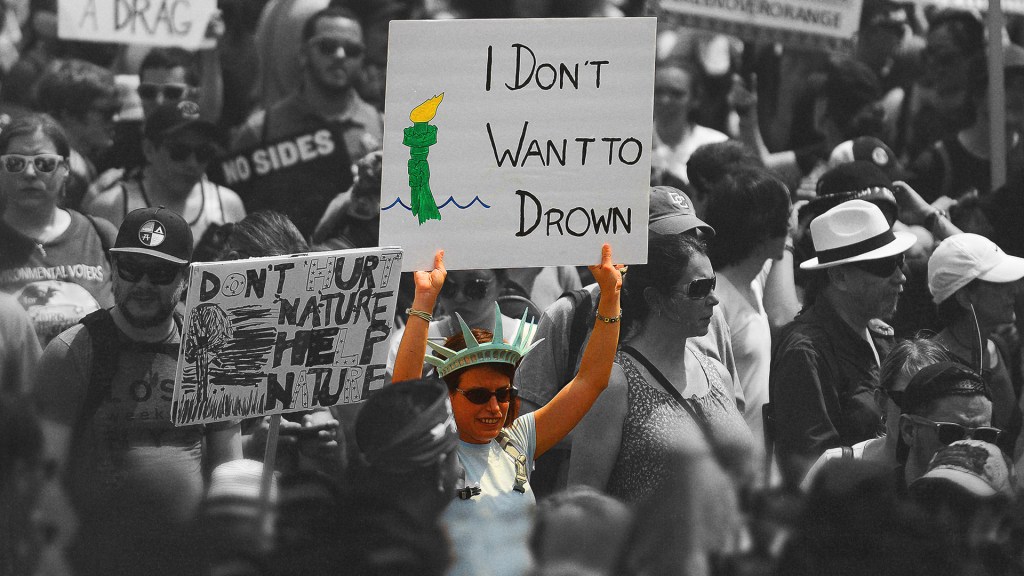When people ask what they can do personally to fight climate change, the advice they get is normally not all that great. Riding your bike, avoiding drinking straws, eating less meat, boiling water more efficiently or undertaking any number of personal lifestyle actions is unlikely on its own to lead to the massive and immediate economic changes scientists calculate are required to avoid catastrophe.
The vast majority of carbon emissions are caused by infrastructure and systems—such as a coal-fired power grid or car-dependent suburbs—over which any one person has little control. So reducing your comparatively tiny personal carbon footprint won’t help, and in fact it could be counterproductive, some experts argue, because it distracts you from the need for systemic change.
Videos by VICE
But it doesn’t mean you’re powerless. VICE recently spoke with organizers and strategists associated with Occupy Wall Street, the Sunrise Movement, Extinction Rebellion, Indivisible and “The Squad”—comprised of congresswomen Alexandria Ocasio-Cortez, Ilhan Omar, Rashida Tlaib and Ayanna Pressley—who said you have more leverage and influence over our planet’s fate than you’re likely aware.
Here are five practical ways you can wield it.
1. Join a climate group—or start one with friends
Vast, system-wide change seems difficult, but it’s possible if enough people demand it. Past successful social movements have resulted in the New Deal in the 1930s, civil rights legislation in the 1960s, and same-sex marriage legalization in the 2010s. In each case, a major change in law came about only after everyday people had done the hard, on-the-ground work of organizing.
“The biggest thing people can do is join groups,” said Paul Engler, co-founder of the social-movement training institute Momentum, which has worked with the Sunrise Movement, Black Lives Matter, and others. “They need to have a group so they can participate, even if it’s a minimal commitment.”
There are two ways to go about this. Engler used to recommend that you find climate change groups linked to your community. If you belong to a union, join your union’s climate group. Or sign up at your church. But U.S. society has become so fragmented and solitary (see for example Robert Putnam’s classic book Bowling Alone about the disintegration of civic and social ties in America) that you might not belong to any community organizations at all.
If this is the case, Engler said, “it makes sense for people to form small groups.” The strategy here is to get a few friends together and create a local chapter of a larger organization or campaign. So that could mean affiliating your group with 350, Sunrise, or simply the broader effort to pass a Green New Deal.
“We need massive amounts of people to be doing that,” said Engler.
The bare minimum your group should do is support calls for action from the wider network of people fighting for aggressive climate action. It could mean, for instance, taking part in the Global Climate Strike on September 20 to 27. There are lots of other ways you or your group can specifically contribute—some of which we’ll examine in greater depth below—but first it helps to understand how social- movement thinkers view our political era.
2. Directly confront the people in power (in person, if possible)
We are living through what movement advisor and former Occupy Wall Street organizer Jonathan Smucker calls “a crisis of legitimacy.” Our political and economic system is so obviously failing—to the point where it’s destabilizing the foundation for all human life and leading to inequality not seen since the Great Depression—that vast numbers of people are losing faith in it.
“What that means is dominant narratives like bootstraps and upward mobility and the American Dream… stop resonating,” Smucker said.
This creates the conditions for outsider challengers to amass huge power in short periods of time—as when Donald Trump went from reality TV star to joke candidate to president, or Ocasio-Cortez’s journey from bartender to progressive superstar.
You can potentially tap into this revolutionary fervor by picking fights with political elites who represent the status quo. That may sound abstract and a bit intimidating, but it could be as simple as getting five people to show up at your representative’s local office with a smartphone camera and demanding that they support the Green New Deal.
When some children with Sunrise did that back in February with Democratic Senator Dianne Feinstein, the ensuing confrontation went viral. And one of the main reasons we’re talking about a Green New Deal at all is because of the young Sunrise activists who occupied Nancy Pelosi’s office last November.
“It’s a different kind of fight than ‘we should care about nature,’ or the guilt-laden one of ‘we should recycle’ or ‘what can we as individuals do,’” Smucker said.
Here are a few tips for identifying the right politicians to confront. If you’re represented by a Republican, it’s usually a good bet that they take oil and gas money and are opposed to climate action. They might not even believe climate change is real. That makes them potentially effective targets for activism.
If it’s a Democrat, check this database run by OpenSecrets to see if they’ve received contributions from fossil fuel companies (this site is also useful for looking up Republicans). Anyone endorsed by the Blue Dog PAC (which includes “Big Oil’s favorite Democrat” Henry Cuellar) or by NewDems (who have attacked the Green New Deal and said we need to fight the climate crisis “incrementally”) is probably also a target.
3. Seek out and volunteer for politicians who are not beholden to corporations —before a vote is even imminent
Maybe you want to take this one step further and actually get status-quo politicians out of office. One way you can do this is by assisting the election campaigns of people known as “movement candidates.” They are politicians who derive their power from small donations and working with grassroots climate organizations rather than corporate donors or other traditional power brokers.
This in theory allows those politicians greater freedom to advocate for aggressive climate action like making the U.S. carbon-neutral by 2030, which would likely result in a massive decline of the fossil-fuel business model.
“Movement candidates… focus on fighting with urgency, like they’ve got nothing to lose, for solutions as radical as the problems that we’re facing,” said Alexandra Rojas, executive director of the group Justice Democrats, which last year recruited Ocasio-Cortez to run for office and also endorsed Omar, Tlaib, and Pressley.
Justice Democrats has a list of 2020 candidates they consider to fit the criteria. Here are questions to ask when identifying movement candidates in your area: Do they refuse fossil fuel donations? Are they endorsed by member-driven climate groups or others fighting for social justice? Have they committed to stopping Trump’s climate denial and forcing the Democratic Party to offer an aggressive alternative?
The very least you can do is “show up to make phone calls or knock on doors the last week before election day,” according to a “Resistance Guide” Engler helped write. But contacting a candidate’s campaign well before an actual vote and offering to volunteer your time and resources—by, for example, hosting a community fundraiser—can be much more effective.
“We can elect champions for a Green New Deal who are going to take the climate crisis seriously, but it’s not getting involved six months from now, the fight is happening right now,” Rojas said.
4. Call your representatives, even if they are already doing what they should be doing
Maybe you don’t live in the kind of district that would elect the next Ocasio-Cortez. Or perhaps you’re just way too busy to dedicate yourself to a gruelling political campaign. A potentially effective alternative is to start making phone calls to your elected representatives—lots of them.
“Make sure you’re tracking and monitoring when important [climate] legislation is coming up in Congress and make your voice heard on a regular basis,” said Leah Greenberg, co-founder of Indivisible, which publishes practical steps modeled after the Tea Party for achieving progressive political change. Indivisible also supports a network of local chapters putting those steps into action.
“Politicians tend to care more about a group than they care about any individual. It’s not personal, it’s just math.”
Indivisible advises you to only phone Congress members who represent you because they are perpetually concerned about reelection and potentially sensitive to what constituents are saying about them.
Here’s what a phone call about the Green New Deal could sound like, according to a guide released by Indivisible earlier this year: If your representative already supports the resolution, urge him or her to “‘talk to their colleagues, especially from our state’s delegation, about signing on in support of the Green New Deal.’”
And if they don’t support the resolution, the guide explains, insist that “‘climate change is the most urgent challenge of our time… I expect [the member of Congress] to reconsider their position.’”
Phone calls can work even better for state-level representatives, especially if they’re on a committee that deals specifically with climate or energy issues. “It can have a huge impact at the state level, where staffers are not used to getting a large volume of calls,” reads another Indivisible guide.
Getting a group of people to make coordinated phone calls—and convincing others in your community to do the same—amplifies the message. “Politicians tend to care more about a group than they care about any individual. It’s not personal, it’s just math. Groups of people have more power,” Greenberg said.
5. Commit an act of nonviolent civil disobedience
Actions like the above apply gradual but steady force on elected officials. But with time rapidly ticking down on our climate emergency, more pressure may need to be brought to bear.
“What you have to do is create a massive load of shit nonviolently,” said Roger Hallam, co-founder of the climate group Extinction Rebellion. In step one, activists undertake high-profile actions that are likely to draw media attention and get them arrested—such as the Extinction Rebellion activists who this July glued themselves to the U.S. Capitol and blocked the streets of London.
Done effectively, it could be the galvanizing trigger for step two, when millions of people stop what they’re doing and come out into the streets. “Basically, the critical authorities don’t have the physical or moral resources to deal with that, and that’s when you get the structural change,” Hallam said, citing research showing that just 3.5 percent of the population being mobilized is enough to topple a government.
One way to take part is show up to an Extinction Rebellion meeting in your city and sign up for a nonviolent direct-action training. “You simulate getting arrested,” he said. “You’ll sit on the floor, some other person will pretend to be a policeperson, they’ll come up, swear at you, drag you off.”
Committing nonviolent civil resistance shouldn’t be taken lightly. It can carry the risk of serious jail time. Hallam advises that anyone planning an action do so openly and publicly (which can lead to a more welcoming culture for participants) and be polite with the police to reduce the odds of an aggressive crackdown.
Whether any single action that you or Extinction Rebellion undertakes is able to cause a revolution is debatable. But Hallam argues the idea of social movements taking down unjust systems during times of crisis is one of the drivers of history.
“This isn’t unbelievable,” he said. “It’s happened a thousand times before.”
Sign up for our newsletter to get the best of VICE delivered to your inbox daily.
Geoff Dembicki is the author of Are We Screwed? How a New Generation Is Fighting to Survive Climate Change. Follow him on Twitter.




